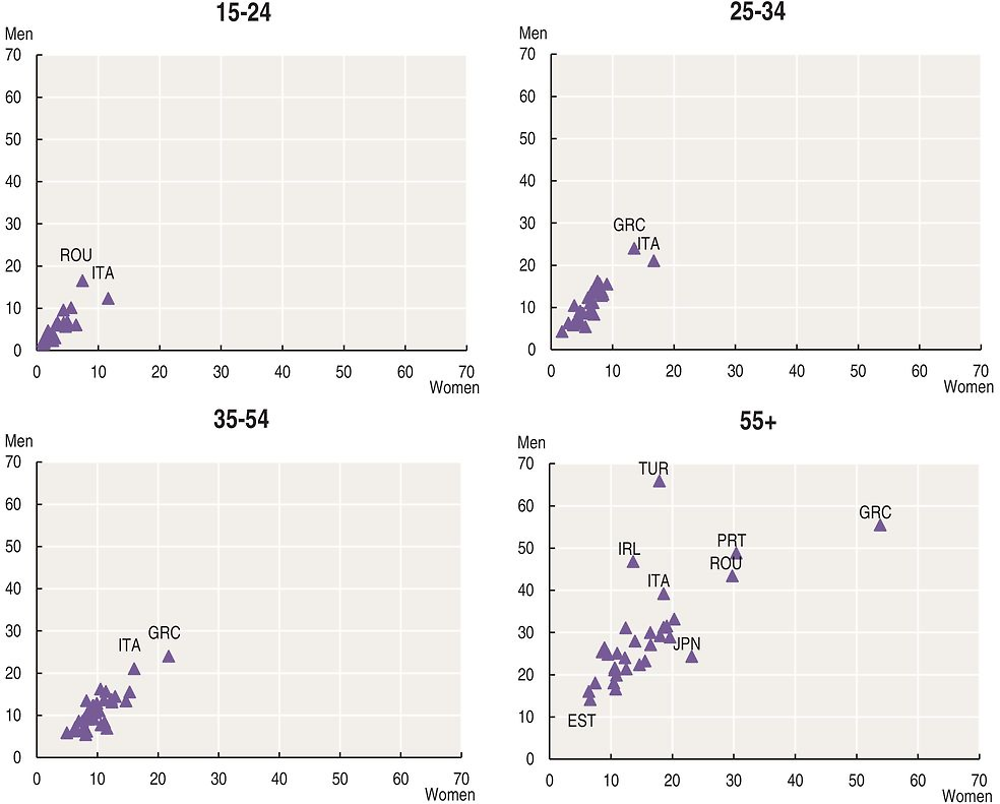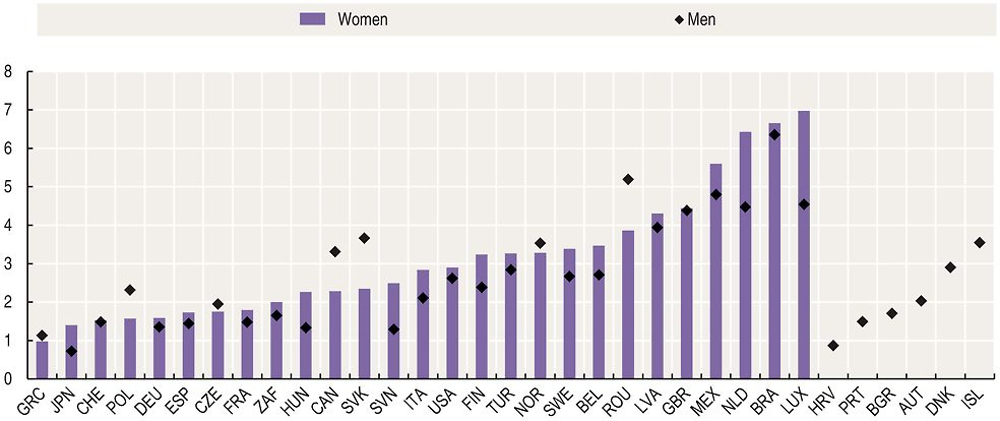Self-employment among the youth
Key facts
-
The gender difference in self-employment is generally visible across all age groups. In all observed OECD countries except Luxembourg, men have consistently higher self-employment rates than women for the age groups 15-24, 25-34, and 55+. For employed persons aged between 35 and 54, by contrast, the female self-employment rate exceeds the male self-employment rate in a number of countries. Though on average the self-employment rate is higher for men in this age group as well, the relative average gender difference between self-employment rates is the smallest of all age groups.
-
In a slight majority of countries, the female self-employed population is younger than the male self-employed population. The share of self-employed women under 25 in these countries is larger than the share of self-employed men under 25. This reflects a more general observation, namely that in the OECD area the gender difference in self-employment is by far largest in the age group 55+. In this age group, on average, the male self-employment rate is almost twice the female self-employment rate.
-
Self-employment increases with age. For both men and women, self-employment rates are higher in older age groups in almost all countries. On average, 5.1% of employed men aged 15-24 are self-employed while 29.2% of employed men aged 55+ are self-employed; on average, 3.6% of employed women aged 15-24 are self-employed while 15.9% of employed women aged 55+ are self-employed.
The self-employment rate by age group and gender is the share of employed people in each age group who are self-employed and not working in agriculture.
The proportion of self-employed women (men) who are below 25 is calculated by dividing the number of self-employed women (men) between 15 and 25 years old by the number of all self-employed women (men).
Information on data for Israel: https://doi.org/10.1787/888932315602.
Relevance
The youth was hit especially hard by the recent crisis. Entrepreneurship and self-employment offer pathways for young people to emerge from unemployment, and also to develop a spirit of entrepreneurship and skills such as initiative, confidence and creativity that help them in their work life and ability to adapt and innovate.
Comparability
Self-employment rates for people who are less than 25 years old are very low in several countries. Comparability issues can be generated by the different treatment of incorporated self-employed, who are considered employees in Japan and Norway. As the young are less likely to have incorporated their business, youth self-employment rates may be lower in countries that restrict the self-employed to those owning unincorporated businesses.
The age group 15-24 refers to 14-24 for Mexico.
Sources
Canada: Labour Force Survey, www23.statcan.gc.ca/imdb/p2SV.pl?Function=getSurvey&SDDS=3701.
Eurostat: Labour Force Surveys, http://ec.europa.eu/eurostat/web/microdata/european-union-labour-force-survey.
Japan: Labour Force Survey, www.e-stat.go.jp/SG1/estat/eStatTopPortalE.do.
Mexico: Encuesta National de Empleo, www.inegi.org.mx/est/contenidos/proyectos/encuestas/hogares/default.aspx.
United States: Current Population Survey, www.census.gov/cps/.
Brazil: National Household Sample Survey, www.ibge.gov.br/home/estatistica/indicadores/trabalhoerendimento/pnad_continua/analise02.shtm.
South Africa: Labour Force Survey, http://interactive.statssa. gov.za:8282/webview/.
Further reading
Hipple, S. and L. Hammond (2016), “Self-employment in the United States”, Spotlight on Statistics, US Bureau Of Labor Statistics, March.
OECD (2016), OECD Report to G7 Leaders on Women and Entrepreneurship: A summary of recent data and policy developments in G7 countries, www.oecd.org/gender/OECD-Report%20-to-G7-Leaders-on-Women-and-Entrepreneurship.pdf.
OECD (2012), “Policy Brief on Youth Entrepreneurship”, www.oecd.org/cfe/leed/Youth%20entrepreneurship%20 policy%20brief%20EN_FINAL.pdf.


